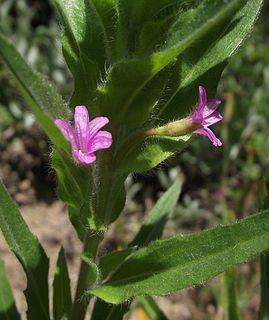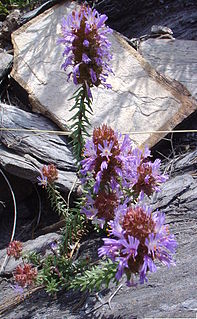
Primula vulgaris, the common primrose, is a species of flowering plant in the family Primulaceae, native to western and southern Europe, northwest Africa, and parts of southwest Asia. The common name is primrose, or occasionally common primrose or English primrose to distinguish it from other Primula species also called primroses. None of these are closely related to the evening primroses.

Circaea lutetiana, known as broad-leaved enchanter's nightshade, is a plant in the evening primrose family, Onagraceae.

Eremothera boothii is a species of wildflower known as Booth's evening primrose. This plant is native to the western United States and northwestern Mexico where it is most abundant in arid areas such as deserts. This is an annual plant with hairy reddish-green stems and mottled foliage. The stem ends in a nodding inflorescence of many small flowers which may be white to red or yellowish, often with darker shades on the external surfaces of the four spoon-shaped petals. They have long stamens with clublike yellowish anthers. Flowers of this species tend to open at dusk rather than dawn as in many other Camissonia. The fruit is a twisted capsule one to 3 centimeters long. Plant appearances may vary across subspecies.

Chylismia claviformis is a species of wildflower known as browneyes or brown-eyed primrose. It is an annual plant growing from a basal rosette of long oval leaves and producing stems often exceeding half a meter in height. Atop the stem is an inflorescence of one to many primrose blooms, each with four white or yellow petals. The pistil may be quite long and has a bulbous stigma at the tip. The stamens are somewhat shorter and they bear long hairy anthers containing white or yellow pollen. The floral axis at the junction of male and female parts is bright red to maroon or brown. This species is found across western North America from the Pacific Northwest to northern Mexico.

Epilobium densiflorum is a species of willowherb known by the common names denseflower willowherb, dense spike-primrose or dense boisduvalia. It is native to western North America from British Columbia to Baja California, where it is found in a variety of habitats. This is an erect annual often exceeding a meter in height with fuzzy green foliage. The pointed leaves are up to 8 centimeters long near the base of the plant, and the upper leaves are generally more hairy than the lower. The stem may branch or not. The top of the stem is occupied by a hairy, leafy, densely flowered inflorescence. Each flower has four deeply notched petals in shades of pinkish purple to nearly white with dark veining, each about a centimeter long. The fruit is a cylindrical capsule about a centimeter long.

Erysimum cheiri syn. Cheiranthus cheiri, the wallflower, is a species of flowering plant in the family Brassicaceae (Cruciferae), native to Europe but widespread as an introduced species elsewhere. It is also widely cultivated as a garden plant.

Camissoniopsis micrantha is a species of flowering plant in the evening primrose family known by the common name miniature suncup. It is endemic to California, where it grows along the coast and in the coastal mountains as far north as the San Francisco Bay Area, as well as in the Central Valley. It grows in sandy areas in a number of habitats, from beaches to inland slopes. This is a small, hairy annual herb producing a basal rosette of leaves. The stem varies in morphology, approaching half a meter in erect height or quite short and flat, with or without branching. The larger leaves are located in the basal rosette; those on the stem are narrow and shorter. The inflorescence produces bears a number of flowers with petals less than 5 millimeters long. They are bright yellow and dry to a reddish color as they close. If the inflorescence is located on an erect stem it bends the stem over with its weight. The flowers self-pollinate. The fruit is a cylindrical capsule 1 to 2 centimeters long.
Androsace filiformis is a species of flowering plant in the primrose family known by the common names filiform rockjasmine and slender-stemmed androsace.

Clarkia exilis is a small herbaceous annual plant of western North America. It is an uncommon species in the evening primrose family known by the common names Kern River clarkia and slender clarkia.

Taraxia tanacetifolia is a species of evening primrose known by the common name tansyleaf evening primrose. It is native to the western United States, particularly the Great Basin and the mountains of the Pacific Northwest. It is a perennial herb growing from a woody taproot and spreading via lateral shoots. It lacks a stem and takes the form of a flat rosette of hairy leaves with a central inflorescence. The frilly leaves are long and narrow, lined with deep, irregular, narrow lobes. The leaf blades are up to about 30 centimeters long and are borne on long petioles. The flowers at the center of the rosette have bright yellow petals up to about 2.3 centimeters long. The fruit is a swollen, leathery capsule containing two rows of seeds.
Epilobium pallidum is a species of flowering plant in the evening primrose family known by the common name largeflower spike-primrose. It is native to western United States, where it grows in moist areas in northern California, Oregon, and Idaho. It is an annual herb producing a narrow, upright stem up to 60 centimeters long lined with narrow oval leaves each up to 5 centimeters in length. The inflorescence atop the stem bears several flowers and hairy, leaflike bracts. Each flower has four bilobed petals each up to about a centimeter long and bright pink in color. The fruit is a beaked capsule between 1 and 2 centimeters long containing a row of tiny seeds.

Epilobium siskiyouense is a rare species of flowering plant in the evening primrose family known by the common names Siskiyou willowherb and Siskiyou fireweed.

Oenothera laciniata is a species of flowering plant in the evening primrose family known by the common name cutleaf evening primrose. It is native to the eastern United States but it can be found in many other places as an introduced species and sometimes a noxious weed. It is reported from Hawaii, Australia, Britain, France, Korea, Japan, and other areas. This is an annual or short-lived perennial herb producing a spreading stem from a hairy rosette of deeply cut or lobed leaves. Flowers occur in the axils of leaves higher on the stem. Each flower has pale to deep yellow petals up to about 2 centimeters long which fade orange, pink, or red with age. The fruit is a cylindrical capsule up to 5 centimeters in length.

Oenothera primiveris is a species of flowering plant in the evening primrose family known by the common names yellow desert evening primrose, bottle evening-primrose, and desert evening-primrose.
Oenothera xylocarpa is a species of flowering plant in the evening primrose family known by the common name woodyfruit evening primrose. It is native to the Sierra Nevada of California, its range extending just into western Nevada. It grows in coniferous forest and meadow habitat, often in soils rich in pumice and other gravel. It is a perennial herb growing from a thick taproot and producing a flat, dense rosette of hairy, gray-green leaves. There is no stem. The showy flowers appear amidst the leaves. Each has four petals which may be nearly 4 centimeters long, bright yellow in color, fading pink to red with age. The fruit is a straight, curving, or twisting capsule which may be up to 9 centimeters long.

Primula sieboldii, the Japanese primrose, is a species of primrose that is endemic to East Asia. The species goes by common names such as Siebold's primrose, cherry blossom primrose, Japanese woodland primroseSnowflake, Geisha girl, Madam butterfly and the Japanese primrose which also applies to the related species Primula japonica.

Coris monspeliensis, a plant species in the primrose family, has erect or ascending stems which are woody at the base and densely covered with foliage. The leathery linear leaves, which grow up to 20 mm long are alternate and stalkless. They may be hairless or hairy and the highest leaves often have small teeth. The flowers with 5 unequal petals, each deeply lobed are borne in short dense clusters and vary in color from pink to blue. Each flower measures up to 12 mm across and has narrow, widely spread petals. The calyx is bell shaped and has up to 20 red or black spiny teeth. The spherical capsule is up to 2 mm in diameter.

Persoonia coriacea, commonly known as the leathery-leaf persoonia, is a shrub native to the wheatbelt in Western Australia. First collected by one Max Koch on 30 November 1923, it was described by James W.C. Audas and P.F. Morris in 1928. Within the genus Persoonia, P. coriacea is classified in the lanceolata group, a group of 54 closely related species with similar flowers but very different foliage. These species will often interbreed with each other where two members of the group occur; in the case of this species, it hybridizes with P. helix.
Ludwigia pilosa, the hairy primrose-willow, is a species of plant in the family Onagraceae.














